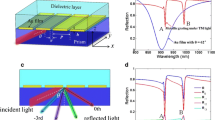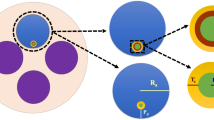Abstract
In this paper, indium tin oxide (ITO) is considered as an alternative plasmonic material beyond conventional plasmon generating metal. A total of 150-nm-thick ITO film-based Kretschmann configuration is demonstrated in NIR region. Minimum possible reflectance with optimum FWHM of resonance plot is the essential criteria for the incident angle selection of the said structure to increase the sensitivity and improve the performance of SPR biosensors in wavelength interrogation mode. Reflectance, phase, and field enhancement curves have been studied for different gaseous samples, and corresponding wavelength sensitivity has been calculated for the change of refractive index of the sample in the order of two. Differential resonance parameters have also been studied which are found to provide increased sensitivity. Theoretical simulation-based results validate that the proposed sensor can provide higher sensitivity by measuring the differential phase.






Similar content being viewed by others
References
Exarhos GJ, Zhou XD (2007) Discovery-based design of transparent conducting oxide films. Thin Solid Films 515:7025–7052
Naik GV, Boltasseva A (2010) Semiconductors for plasmonics and metamaterials. Phys Status Solidi RRL 4:295–297
Rhodes C, Weibel S, Maria JP, Losego M, Leonard DL, Laughlin B, Duscher G, Franzen S (2006) Surface plasmon resonance in conducting metal oxides. J Appl Phys 100:054905
Franzen S, Rhodes C, Cerruti M, Gerber RW, Losego M, Maria JP, Aspenes DE (2009) Plasmonic phenomena in indium tin oxide and ITO–Au hybrid films. Opt Lett 34(18):2867–2869
Naik GV, Shalaev VM, Boltasseva A (2013) Alternative plasmonic materials: beyond gold and silver. Adv Mater 25:3264–3294
Robusto PF, Braunstein R (1990) Optical measurements of the surface plasmon of indium-tin oxide. Phys Stat Sol A 119:155–168
Michelotti F, Dominici L, Descrovi E, Danz N, Menchini F (2009) Thickness dependence of surface plasmon polariton dispersion in transparent conducting oxide films at 1.55 μm. Opt Lett 34:839–841
Rhodes C, Cerruti M, Efremenko A, Losego M, Aspnes DE, Maria JP, Franzen S (2008) Dependence of plasmon polaritons on the thickness of indium tin oxide thin films. J Appl Phys 103:093108
Wang Y, Dong J, Luo Y, Tang J, Lu H, Yu J, Guan H, Zhang J, Chen Z (2017) Indium tin oxide coated two-mode fiber for enhanced SPR sensor in near-infrared region. IEEE Photonics J 9:4801309
Shukla S, Sharma NK, Sajal V (2016) Theoretical analysis of surface plasmon resonance based fiber optic sensor using ITO and ZnO thin films. Opt Quant Electron 48:1–9
Rajak S, Ray M (2014) Comparative study of plasmonic resonance in transparent conducting oxides: ITO and AZO. J Opt 43:231–238
Maslov V, Dorozinsky G, Kachur N (2016) Investigation of sensors based on ITO nanofilms in SPR-devices. Am J Opt Photonics 4:20–24
Banerjee J, Ray M (2019) Comparative performance evaluation of mono-metallic and bi-metallic plasmonic sensors using WS2 and graphene with optical bio-sensing application. Sens Actuators B Chem 281:520–526
Banerjee J, Bera M, Ray M (2017) Theoretical differential phase analysis for characterization of aqueous solution using surface plasmon resonance. Plasmonics 12:1787–1796
Bera M, Banerjee J, Ray M (2017) Theoretical investigation on coupled plasmon waveguide resonance in real and complex domain for high precision nanoplasmonic sensing. IEEE Trans Nanotechnol 16:462–468
Banerjee J, Ray M (2018) Resonant behaviour of coupled plasmonic waveguide structure and its application in sensing. Presented at International Conference on Microwave and Photonics, held in IIT (ISM) Dhanbad, India, IEEE proceedings 978–1–5386–0933–0/18/$31.00 ©2018 IEEE, ISBN 978–1–5386–0932–3
Funding
The author J. Banerjee received financial support from the Department of Science and Technology, India (Ref.No.SR/WOS-A/PM-1015/2015), under Women Scientist Scheme.
Author information
Authors and Affiliations
Contributions
J. Banerjee designed the model, performed the numerical simulations, analyzed the data, and wrote the manuscript. S. Rajak helped in literature survey and overall guidance by M. Ray.
Corresponding author
Ethics declarations
Competing Interest
The authors declare that they have no competing interest.
Ethical Approval
Yes.
Consent to Publish
Yes.
Additional information
Publisher’s Note
Springer Nature remains neutral with regard to jurisdictional claims in published maps and institutional affiliations.
Rights and permissions
About this article
Cite this article
Banerjee, J., Rajak, S. & Ray, M. Exploring Optimization Merit Function-Based Plasmonic Resonance at NIR Using ITO. Plasmonics 16, 939–945 (2021). https://doi.org/10.1007/s11468-020-01361-x
Received:
Accepted:
Published:
Issue Date:
DOI: https://doi.org/10.1007/s11468-020-01361-x




